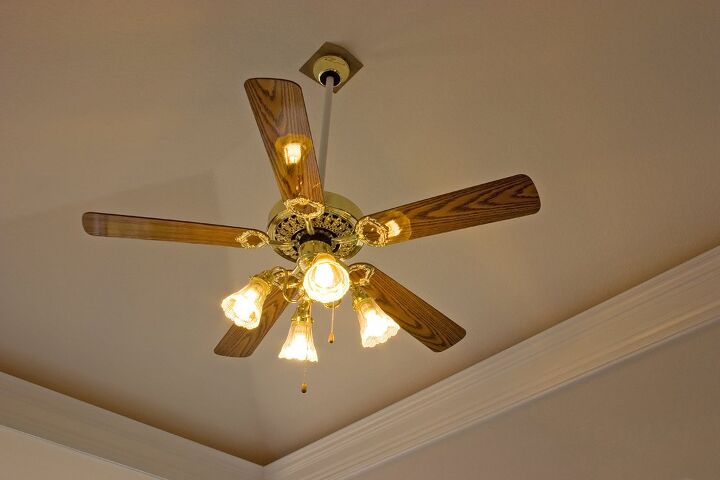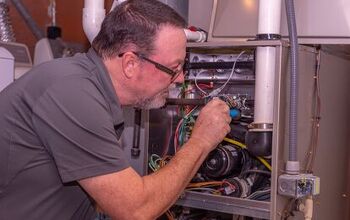Ceiling Fan Light Flickers? (Possible Causes & Fixes)

Your ceiling fan has two jobs: to circulate air and light your room. When your ceiling fan stops doing one of these jobs, it can be a major frustration. A flickering ceiling fan light is not always something to worry about, though it can indicate larger electrical issues.
Your flickering ceiling fan light may be caused by incompatible, old, or loose light bulbs. Your home may have old light switches, old fixtures, or a current limiter that has gone bad. The lights may be flickering because of overloaded circuits or loose wiring, which are more serious problems.
Related Content: Ceiling Fan Light Turns On By Itself? | Can LED Bulbs Be Used In Ceiling Fans? | Most Common Ceiling Fan Problems
Do You Need Ceiling Fan Repair Services?
Get free, zero-commitment quotes from pro contractors near you.

Why Your Ceiling Fan Light Is Flickering
Several things could cause your ceiling fan light to flicker. Not all of the reasons should be a cause for immediate concern.
Incompatible Light Bulbs
Some bulbs work with light fixtures better than others. Fluorescent bulbs tend to flicker as a result of temperature changes, age, and warm-up cycles. If your light fixture has fluorescent bulbs, try replacing them with incandescent or LED bulbs.
If you have a dimmer switch, LED bulbs aren’t necessarily the best bulb to pair with this type of switch. Dimmer switches tend to work best with standard incandescent bulbs.
To fix flickering caused by this pairing, replace the LEDs with incandescent bulbs. You can also switch your LEDs out for dimmable bulbs and forego using your dimmer switch altogether.
Old Light Bulbs
If you’ve had a light bulb in your ceiling fan for quite some time, it’s age may be the problem. As light bulbs get close to burning out, they may begin to flicker. This is particularly common with fluorescent bulbs as opposed to newer LEDs.
To remedy this, replace your old fluorescent bulbs with LEDs or incandescent bulbs.
Loose Light Bulbs
If the lights in your ceiling fan are flickering, this may be caused by loose light bulbs. If a light bulb wasn’t screwed in tight enough, the fan’s vibrations can cause it to loosen and flicker.
To fix a loose light bulb, turn off the lights to that fixture. Either wait for the light bulbs to cool off (unless you’re using LEDs, which don’t generate heat) or wear gloves. Tighten all suspected loose light bulbs and give the secure ones an extra twist for good measure.
Old Switches
If you’ve tightened all your ceiling fan’s light bulbs but they’re still flickering, it might be the light switch. Dimmer switches built into older houses are sometimes incompatible with newer bulbs. Flip switches may also cause flickering if there is loose or old wiring behind them.
There are a few telltale signs that your light switch is getting old. If you flip the switch and hear audible popping, sizzling, or buzzing, this means it’s time to replace it. Likewise, if the switch feels hot or sparks when turned on, this is also a sign it needs replacing.
If you have a dimmer switch, check the ratings on your switch and light bulbs. This will let you know whether you’ve got a compatible set or not. A mismatched set can cause flickering.
Switching Your Switch
If a mismatch isn’t the issue, it’s time to replace your switch. To keep using a dimmer switch, replace your current switch with a dimmer meant for LEDs. This will require dimmable LED bulbs as well, but should prevent flickering due to incompatibility.
If you suspect there may be old or loose wiring behind your light switch, this can be the cause of your flickering light. Have an electrician repair or replace the wiring to fix the flickering and your light switch.
The cost to replace a light switch can range from $65 to $125. Price varies depending on the type of switch and how much new rewiring has to be done. If both your switch and fixture are the cause of the problem, it can cost nearly $400 to replace both.
Installing a new switch should only take about half an hour. However, if you’re installing a more complicated switch like a dimmer, it can take several hours.
Old Fixtures
If your house is older, it’s likely that you have older light fixtures. An old ceiling fan light fixture may be the cause of flickering lights. To remedy this, replace your old fixture.
Unless you have wiring experience, replacing the old fixture should be the work of an experienced electrician. This will ensure that the new fixture is wired correctly.
If you were to attempt a DIY install of a new ceiling fan lighting fixture, you would need an electrical permit. This ensures your insurance company that all the wiring in your home is up to code. Because of this, hiring a professional will probably be your best bet when it comes to installing a new fixture.
Bad Current Limiter
Some light fixtures and ceiling fans come with a current limiter that prevents high wattage bulbs from overheating. Lights flickering in your ceiling fan may be a result of a current limiter that has gone bad. You can fix this problem by removing the current limiter.
You should replace the current limiter with a new one to ensure the bulbs do not overheat. If you aren’t used to working with wires, have an electrician remove the current limiter. This will prevent any damage to yourself or the ceiling fan.
A current limiter can be purchased for a little more than $10 from Amazon or most hardware stores.
Overloaded Circuits
If you notice your lights flickering every time a larger appliance kicks on, your circuit is probably overloaded. These large appliances are drawing current for the circuit when they turn on. Sufficient current would allow many things in your home to be running at once without issue.
If your refrigerator kicks on and your ceiling fan lights flickers, this results from the insufficient current. Your current circuit is overloaded and doesn’t have enough electricity to go around. This also indicates that larger appliances and your lights are wired on the same circuit, which shouldn’t be the case.
Most modern homes require each high-demand appliance to be on its own circuit. However, in older homes, it is not uncommon for multiple appliances and lights to be wired together.
Lighten the Load
To lessen the load on the circuit, replace your current bulbs with low-wattage LED bulbs. These will draw less power than incandescent or fluorescent bulbs.
To determine which appliance is causing the flickering, try powering each on at the circuit breaker. Once you determine the cause of the flicker, contact an electrician. A professional can add another circuit to separate that appliance from your lights.
Be aware that an overloaded circuit breaker can be dangerous and lead to electrical fires. On a less threatening note, an overloaded circuit breaker can also damage your appliances.
Loose Wiring
The lights in your home may be flickering if there is a problem with your wiring, or it’s very old. After testing all the other possibilities, contact an electrician. An electrician can repair loose or replace old wiring.
Loose wiring can easily cause electrical fires, so it is imperative to have this fixed. Left untreated, loose wiring will continue to cause more flickering.
Video: Fixing a Flickering or Blinking Ceiling Fan Light
Do You Need Ceiling Fan Repair Services?
Get free, zero-commitment quotes from pro contractors near you.

Related Questions
Is a flickering ceiling fan light dangerous?
A flickering ceiling fan light is not necessarily dangerous. Usually, flickering indicates that bulbs are old, loose, or incompatible with the fixture. If you suspect your lights are flickering due to electrical issues, this can quickly become dangerous. Overloaded circuits or loose wiring can cause electrical fires or damage appliances.
What are the warning signs of an overloaded circuit?
Flickering lights are a major sign of an overloaded circuit. When other appliances are turned on, lights may flicker and dim if the circuit is overloaded. If you notice a spark or feel a shock when flipping a light switch, this can also be a sign of an overloaded circuit. If you smell something burning when turning on a light, this is another sign of an overloaded circuit.
How much electrical work can you DIY?
Whether you can do your own electrical work varies from state to state. Call your local permit office to make sure you can DIY something before steamrolling ahead. While it is definitely possible to fix your flickering lights by yourself, it will require some electrical knowledge. If you have this and an electrical permit, you should be all set to DIY your electrical work. However, if you have no clue how wires work and suspect a larger electrical problem, contact an electrician. An overloaded circuit or loose wiring is potentially dangerous and should be corrected as soon as possible.
Related Guides

Stacy Randall is a wife, mother, and freelance writer from NOLA that has always had a love for DIY projects, home organization, and making spaces beautiful. Together with her husband, she has been spending the last several years lovingly renovating her grandparent's former home, making it their own and learning a lot about life along the way.
More by Stacy Randall



























